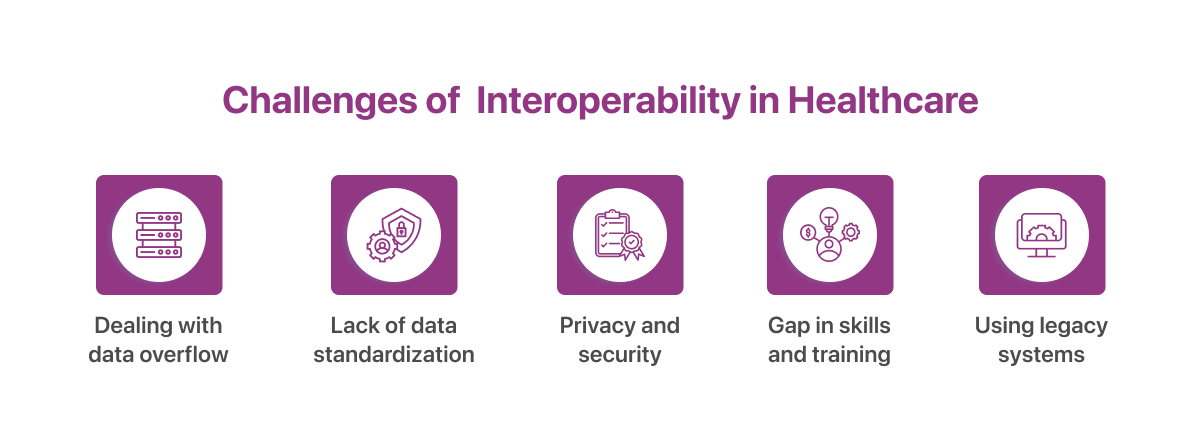Is Data Interoperability in Healthcare Complicated?
In 2021, about 71% of U.S. physicians acknowledged the difficulty of working with the staggering volume of patient data available to them. Around half of the hospitals in the U.S. expected managing this data to be the biggest challenge to improving healthcare interoperability and patient outcomes (source: Statista). These numbers highlight the importance of streamlining the exchange and management of such vast data.
Since as far back as 2009, the government has passed several rules and legislations enabling healthcare organizations to modernize the way they handle data. Right from the Health Information Technology for Economic and Clinical Health (HITECH) Act in 2009 to the ONC or Office of the National Coordinator for Health IT’s 21st Century Care Act and the proposed U.S. Department of Health and Human Services (HHS) rules, interoperability in healthcare has been the focal point.
Yet, compliance with these regulations is just one aspect of interoperability. Healthcare leaders should ensure that their organizations are equipped with modernized processes to execute the primary domains of interoperability, which include electronically sending, receiving, finding, and integrating health information with systems outside their own organization. But there are some challenges to be addressed. Let us find out what they are and how to effectively fill in the gaps.
Challenges to Healthcare Interoperability Continue to Persist

The latest interoperability regulations focus on making it easy for healthcare organizations to exchange information outside their systems through health information exchange (HIE). However, the interoperability rules do not address issues such as patient matching challenges in the face of quick implementation timelines. This, combined with the usage of legacy systems, lack of terminology standardization, and the continuous generation of health data, adds to the problem.
- Dealing with data overflow: Interoperability involves managing vast amounts of healthcare data flowing in from various sources. Some of these sources include data from EHRs, IoT sources, health apps, HIEs, and clinical trials among others. Filtering and prioritizing critical information is essential when dealing with this information overload. Data integration tools and healthcare analytics solutions can be utilized to analyze and extract critical information while promoting consistency and interoperability.
- Lack of data standardization: While most healthcare organizations have adopted EHR systems today, hundreds of EHR systems are available in the market, each using its own standards and terminologies. While standardized record formats such as FHIR and HL7 are gaining wider attention, the use of different EHR systems makes it hard to convert data into an easily sharable, standardized format. Using a single comprehensive Clinical Management System (CMS) helps by facilitating patient data storage, retrieval, and management.
- Privacy and security are still a grey area: Healthcare data often contains sensitive and personally identifiable information. Striking a balance between sharing information for improved patient care and protecting patient privacy can be challenging. Cybersecurity threats and murky waters when it comes to patient consent for data exchange add to the challenge. In the U.S., regulations such as the Health Insurance Portability and Accountability Act (HIPAA) impose stringent data security and privacy requirements.
- A gap in skills and training: Bridging the interoperability gap within and between healthcare organizations is time-and-skill-intensive. Providing training to existing workers or hiring experts can prove to be an expensive process for many organizations. Sometimes, healthcare professionals may resist adopting new technologies or changing established workflows. Key stakeholders should take notice and address these concerns through proper planning and implementation.
- Using legacy systems: When it comes to modernizing their IT infrastructure, many healthcare organizations face budgetary constraints. With clinicians, insurers, and government agencies working in silos, using legacy systems results in a lack of effective collaboration. Organizations struggling with outdated IT systems also face challenges when it comes to staying compliant with various interoperability regulations.
Can These Interoperability Challenges Be Addressed?
Addressing the interoperability challenges discussed in the previous section can lead to improved patient outcomes and data-driven clinical decision-making. To achieve this, healthcare organizations can take several steps:
- Adopting and utilizing widely recognized interoperability standards such as HL7 and FHIR.
- Promoting a collaborative use of standardized coding systems and terminologies like SNOMED CT.
- Implementing secure data exchange protocols, encryption, and secure authentication measures to ensure the privacy and security of patient data.
- Ensuring compliance with data protection regulations, such as HIPAA.
- Developing strategies for modernizing legacy systems, ensuring compatibility with interoperability standards such as FHIR and HL7.
Exploring Some More Options
- Artificial Intelligence for the win: AI (Artificial Intelligence) and ML (Machine Learning) work together to enhance healthcare data interoperability. With AI-driven solutions now a hard reality, seamless integration of diverse healthcare data sources is becoming achievable. These technologies enable data matching, linking patient records, and automating data cleansing to improve accuracy and reliability by sifting through decades of collected data. ML also assists in code mapping, ensuring standardized communication between disparate systems.
- Enter Data Warehousing: Much like a normal warehouse, a data warehouse serves as a centralized repository for healthcare data, consolidating information from various sources into a single, unified platform. Data warehouses are designed to handle large volumes of data efficiently. As healthcare data grows, scalable data warehousing solutions can accommodate the increasing demand for storage and processing. Data warehouses facilitate the integration of diverse datasets, enabling healthcare organizations to merge information from EHRs, claims, imaging systems, and more. Data warehouses are set to become more advanced as more organizations adopt FHIR.
- The importance of APIs: APIs play a crucial role in promoting interoperability by enabling the secure exchange of data and functionalities across different systems. They serve as gateways that allow healthcare applications, such as Electronic Health Records (EHRs), clinical management systems, and third-party services, to connect and share information. Whether in telemedicine, data exchange between healthcare providers, or the integration of emerging technologies, APIs empower the healthcare industry to build interconnected and interoperable ecosystems for improved patient care and data-driven decision-making.
How Can Rockit Help?
We are experts in achieving interoperability in healthcare data management through our world-class HL7 and FHIR software development services. Specializing in FHIR/HL7, we ensure adherence to interoperability guidelines and standards, excelling in creating FHIR-compliant apps that securely share crucial healthcare data.
With technical proficiency in FHIR STU3 and R4, ETL processes, and RESTful APIs, Rockit’s experts facilitate seamless data exchange and robust API development, enhancing connectivity for a new era of healthcare collaboration.
Leveraging deep domain knowledge, we at Rockit understand healthcare workflows and compliance, contributing to a high success rate in delivering accountable results. From FHIR-compliant EHR and data analytics to reusable components and patient portals, Rockit accelerates project timelines, syncing health records, boosting operational efficiency, and providing access to vital health information.
By leveraging these strengths and focusing on FHIR standards, Rockit helps transform isolated healthcare systems into unified solutions, promoting real-world impact through interoperability.

